My name is Linda. I write a bi-weekly newsletter about computer science, childhood, and culture.
My first book for adults, Nähdä maailma hiekanjyvässä, a narrative non-fiction title about computers, comes out on April 16th. This project started with a feeling that there had to be a more poetic, human way to tell the story of computers.
To my English-speaking readers, thank you for your patience as this launch is taking up most of my headspace. There’s a lot happening: a few podcast episodes, an updated website, an updated website, a Goodreads page, and a public event lined up at the central library in Oodi (Finland friends—save the date: April 23rd at 6 PM).
I do hope to have news about a possible translation soon, but publishing is a strange and unpredictable beast. In the meantime, I’ve put together this reference section: part reading list, part field notes, offering a deeper look at the ideas behind the book. Books come from other books and websites can be jumping-off points for more reading. Below is a chapter-by-chapter companion to the book: notes, sources, and suggestions for further exploration.
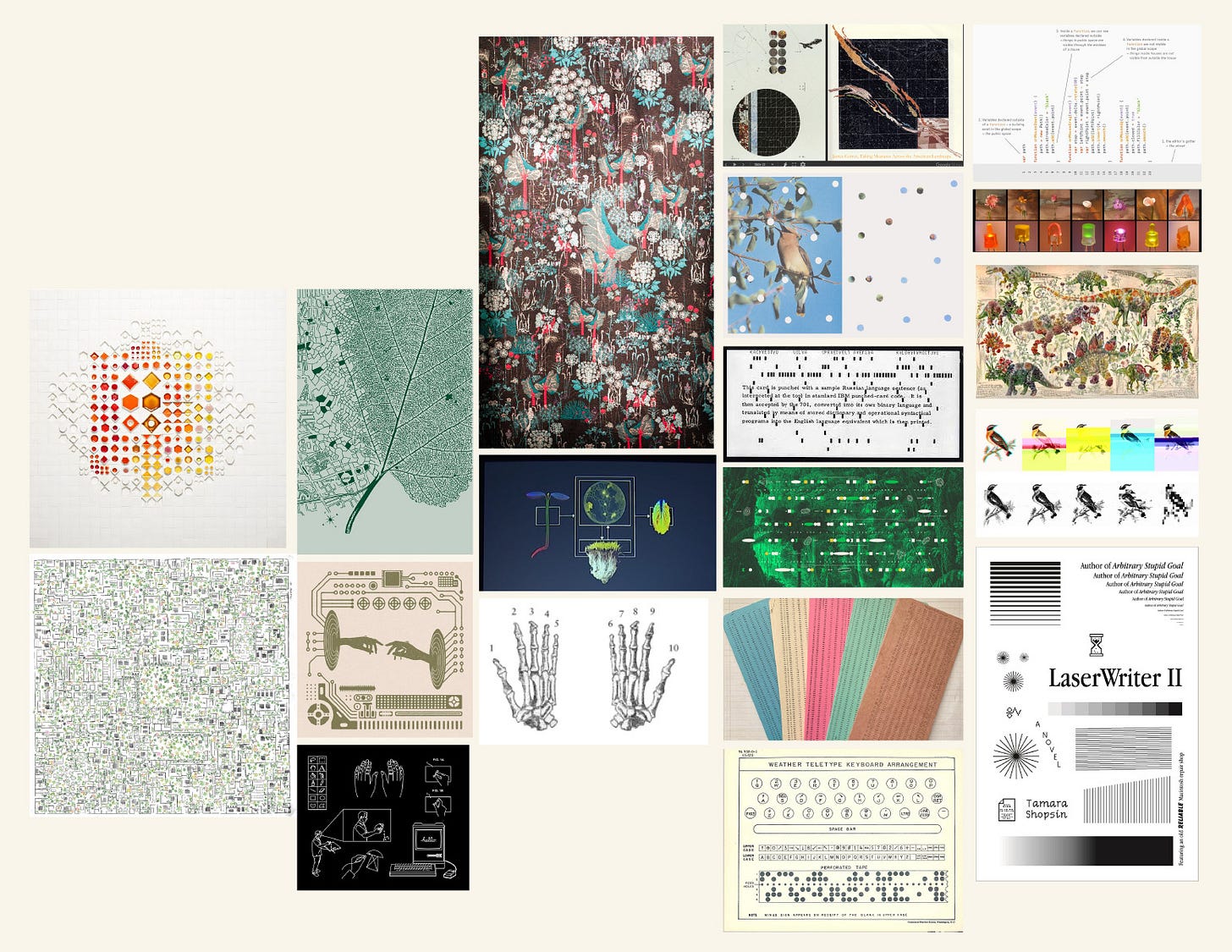
The title of the book, Nähdä maailma hiekanjyvässä, comes from William Blake’s Auguries of Innocence: “To see a world in a grain of sand...” I was first drawn to the idea of the computer as a world inside a grain of sand. Later, I started thinking more about the verb to see, and how it points to the human role in understanding and interpreting technology.
As a child, I loved books that opened with a map—Moominvalley, the Hundred Acre Wood, Mordor. These maps helped me understand where the story was going and gave structure to what I was reading.
When I started learning about computer science, I wished for something similar. The material often felt disconnected—concepts without context or bigger meaning. I wanted a way to see how things fit together.
That’s why this book also functions as a kind of map. It connects people, ideas, and events from the history of computing—from the Jacquard loom and punched cards to the engineers who linked circuits with mathematical logic.
Alongside the fairytale books of my childhood, the map that opens the book was especially inspired by Dominic Walliman’s Map of Computer Science (2017) and its accompanying video. Kate Crawford and Vladan Joler’s Calculating Empires (2023) helped me understand how maps work as tools of power and meaning. Warm thanks also to Eleanor Lutz, whose Constellations from Around the World (2019) influenced the constellation metaphor.
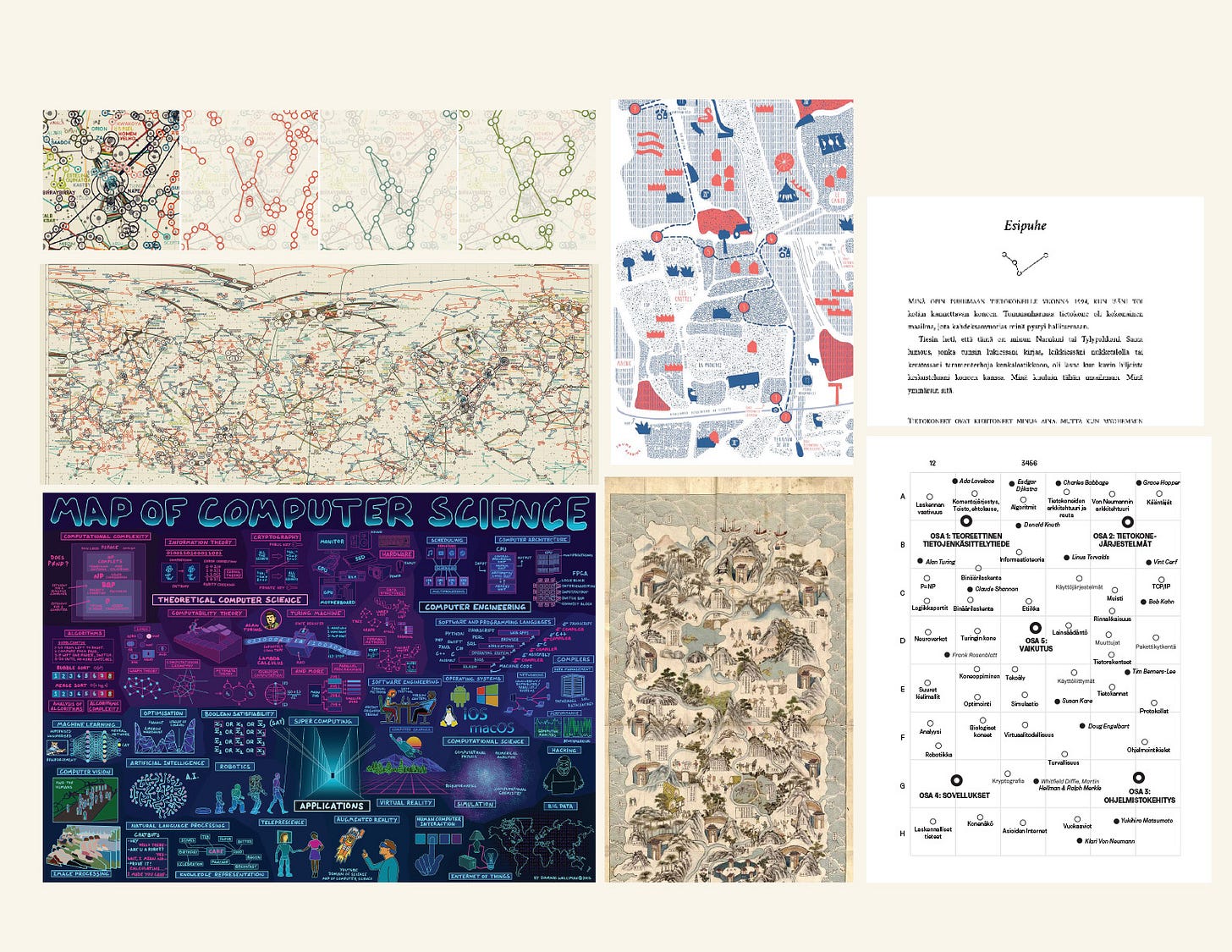
I loved Samuel Arbesman’s The Humanistic Computation Project - a curated list of books and texts that have shaped how I see computing.
On how computer science often hides and shapes discourse through its vocabulary, I found sharp perspectives in:
Ellen Ullman’s Life in Code (2017)
Sherry Turkle’s The Second Self: Computers and the Human Spirit (1984)
James Bridle’s Ways of Being (2022)
Chapter 1: Whose Child Is the Computer?
Two distinct lineages—abstract mathematicians and practical machine makers—came together to create the computer. This chapter traces their intertwined stories and the many origin stories of computers.
George Dyson’s Turing’s Cathedral (2012) describes the early history of the computer. William J. Rapaport’s Philosophy of Computer Science (2024) influenced the chapter titles for Chapters 3 and 4. Matti Tedre’s The Development of Computer Science: A Sociocultural Perspective (2006) helped me understand the discipline as a whole.
Harry R. Lewis’ Ideas That Created the Future (2021) collects foundational papers used in a Harvard course. You can find Andreessen’s original post about the IMG tag here.
Dijkstra’s “knife sciences” metaphor appears in his 1986 memo EWD 924: On a Cultural Gap.
Chapter 2: Lovelace’s Meter
I fell in love with the story of Ada Lovelace, the first programmer, and her poetic vision of computing. The chapter braids together the history of Victorian looms and early computers.
My first programming book was The Ruby Programming Language (2008), by David Flanagan and Yukihiro Matsumoto. Frederick P. Brooks’ The Mythical Man-Month: Essays on Software Engineering (1975) is still a constant companion on my desk.
John Berger’s idea about lace appears in Portraits: John Berger on Artists (2015). It resonates with Jennifer R. Roberts’ A circuitous history of print (2024), which includes Babbage’s caterpillar-weight printing experiments.
Lovelace’s original letters have been digitized by the Clay Mathematics Institute. You’ll find excerpts in James Gleick’s The Information (2011) and Stephen Wolfram’s Untangling the Tale of Ada Lovelace (2015). Also recommended: the blog series pairdebuggingwithlovelace.
The fictional world of Babbage and Lovelace is vividly reimagined in William Gibson and Bruce Sterling’s The Difference Engine (1990). You can see a real Jacquard loom at the Musée des Arts et Métiers in Paris.
Chapter 3: Turing’s Verbs
I build a simple Turing machine out of chocolate, engaging my senses to grasp Alan Turing’s revolutionary idea. Through this tactile experiment, I explore the abstract mathematical concepts that underpin every modern computer and discover something dizzying about the foundations of theoretical computer science.
Charles Petzold’s The Annotated Turing (2008) was my guide as I tried to understand Turing’s machine—its structure and its implications. This chapter simplifies his story, but Petzold’s book includes Kurt Gödel, Alonzo Church, Andrey Markov, and others who helped define the mathematical foundations of computing.
For those curious about chocolate machines, Paul Curzon’s lecture materials are available on the Teaching London Computing website.
A gentler introduction to Turing’s life and his wartime work is the film The Imitation Game (2014).
Chapter 4: Shannon’s Nouns
In 1937, Claude Shannon’s playful master’s thesis linked electrical circuits with Boolean logic and defined the bit—the building block of digital information. Years later, while running a summer school for kids, I unknowingly followed the same logic. Like Shannon, I found that curiosity and play could unlock entirely new ways of thinking about technology.
James Gleick’s The Information (2011) is a book I read the year it came out, and it remains one of the most influential texts in shaping my understanding of computing history.
Jimmy Soni and Rob Goodman’s A Mind at Play: How Claude Shannon Invented the Information Age (2017) offers a rich portrait of Shannon’s life and ideas.
The first time I truly understood the leap between electricity and logic was through Charles Petzold’s Code (2000).
I also recommend Noam Nisan and Shimon Schocken’s The Elements of Computing Systems (2005) and its companion site, From NAND to Tetris, which first drew me into the world of logic gates.
Ilpo Rybatzki’s thesis from our summer school, titled BLOB – Artistic Thinking in the Teaching of Computational Thinking (2016), helped me remember many small details I would have otherwise forgotten.
On the connection between play and science, Steven Johnson writes beautifully in Wonderland: How Play Made the Modern World (2016).
Chapter 5: Von Neumanns' Dictionary
I explore John von Neumann’s groundbreaking role in shaping modern computer architecture and trace how war accelerated technological progress. Along the way, I uncover the overlooked story of Klára von Neumann—John’s wife and an early programmer—whose work on the ENIAC was as vital as it was invisible.
The second season of the Lost Women of Science podcast focuses entirely on Klára von Neumann, whose story piqued my interest. Thank you, Katie Hafner!
Ananyo Bhattacharya’s The Man from the Future (2021) is an excellent biography of John von Neumann. I complemented it with Benjamin Labatut’s more literary The MANIAC (2023). George Dyson also writes about the von Neumann family in Turing’s Cathedral (2012).
On women’s often-muted roles in tech history, I recommend Claire L. Evans’ Broad Band (2018) and the film Hidden Figures (2016), both set in the era that followed Klára.
Chapter 6: Sense for Code
I delve into the culture of programmers, exploring their unique language and their aesthetic sense of code. Through surprising examples of elegance and failure, I ask what makes code beautiful—and why so many programmers fall in love with their craft.
For anyone interested in the culture of programming, I recommend Vikram Chandra’s Geek Sublime: The Beauty of Code, the Code of Beauty (2013).
The fox comic that finally converted me into a Ruby programmer was Why’s (Poignant) Guide to Ruby.
Anna Wiener’s memoir Uncanny Valley is the best portrait I’ve read of the Silicon Valley of my youth. When I need a longer view on software culture, I return to Ellen Ullman—Life in Code is one of my all-time favorite books.
Chapter 7: A World in a Grain of Sand
I take you into the physical world of computing, where machines are born from metal, ceramics, and silicon. This chapter explores the intricate processes of semiconductor fabrication and the hidden complexity behind every chip. A visit to a semiconductor factory in Vantaa gave me a firsthand glimpse into how raw materials from the earth are transformed into the beating heart of modern computers.
Chris Miller’s Chip War: The Fight for the World’s Most Critical Technology (2022) explores the history and significance of transistors. But the first time I truly got excited about the world inside grains of sand was after finding this grainy YouTube video: Indistinguishable From Magic: Manufacturing Modern Computer Chips (2012).
The history of transistors is vast—only a small part could fit in this book. For deeper reading, I recommend Jon Gertner’s The Idea Factory: Bell Labs and the Great Age of American Innovation (2012) and the early chapters of Simon Winchester’s sprawling Pacific (2015).
Chapter 8: On the Importance of Forgetting
In this chapter, I explore the meaning of data, data types, and data structures—woven together with a personal story from Svalbard. While learning about the Arctic Code Vault, a remote archive built to preserve code for the future, I stumbled upon an unexpected link to my own past. The chapter reflects on how we store, forget, and remember information—and how some data is meant to endure, while other bits are gently left behind.
I first became enchanted by the idea of long-term memory for code when I heard an interview with Jon Evans about the Arctic Code Vault. The episode aired on the Changelog podcast and was titled Inside GitHub’s Arctic Code Vault.
Chapter 9: The Last Magician
I explore the intersection of algorithms and magic, tracing their shared history from al-Khwarizmi to modern computer science. Reflecting on Dijkstra’s algorithm and a fable by Goethe, I ask whether reading algorithms might be just as important as writing them. This chapter looks at how magic and technology have long mirrored each other: mysterious until their inner workings are understood, and then no less wondrous.
I first met al-Khwarizmi through Carl Boyer’s classic history of mathematics, Tieteiden kuningatar, which traces mathematical development from prehistory to the 20th century.
For a lucid, popular introduction to algorithms and their influence, I recommend John MacCormick’s Nine Algorithms That Changed the Future. On the magic of code and its cultural resonance, Samuel Arbesman’s forthcoming Magic of Code (2025) was especially influential.
There’s a helpful YouTube explainer titled Dijkstra’s Shortest Path Algorithm Explained | With Example | Graph Theory, if you want to watch the algorithm unfold.
Chapter 10: Where Are All the Wild Things?
I reflect on how children today see the internet as seamless and commercial, unaware of its wild, messy origins. As a 1990s kid who lived both online and offline, I try to teach them about the untamed web that came before. Unexpectedly, Tokyo’s urban planning offers a framework for helping kids navigate the digital world with curiosity and independence.
Seymour Papert could have had an entire chapter of his own, but his influence is most clearly felt here. His book The Children’s Machine: Rethinking School in the Age of the Computer (1993) remains both timely and wise.
To understand the history of the internet, I turned to Katie Hafner and Matthew Lyon’s Where Wizards Stay Up Late: The Origins of the Internet (1996).
The Japanese show はじめてのおつかい (Hajimete no Otsukai) is currently available on Netflix.
Chapter 11: How to Keep a Secret?
I explore the intersection of friendship, competition, and collaboration through the story of cryptography pioneers Diffie, Hellman, and Merkle. Their breakthroughs in secure communication were shaped as much by rivalry as by partnership—reminding me that collaboration lies at the heart of technological progress.
This chapter was inspired by James Somers’ 2018 New Yorker piece The Friendship That Made Google Huge, which sparked my interest in programmers who work in pairs.
Walter Isaacson’s The Innovators: How a Group of Hackers, Geniuses, and Geeks Created the Digital Revolution (2014) also shaped this chapter.
Mixing colors as a metaphor for the encryption process is widely used in teaching.
Part 3
The idea of hope as a form of uncertainty comes from Rebecca Solnit, who describes it beautifully in her book Hope in the Dark: The Untold History of People Power (2004). Another key influence in this section is Ursula M. Franklin, whose The Real World of Technology (1999) is among the sharpest analyses of the interplay between society and technology.
Chapter 12: It Opens With a Smile
I trace how Susan Kare and Doug Engelbart helped make computers personal, from Engelbart’s groundbreaking demo to the Macintosh’s iconic Mona Lisa smile—marking a shift toward more human, accessible interfaces.
I first came across Douglas Engelbart’s demo on YouTube, but his website offers a deeper dive into his world and ideas.
Alongside Engelbart and Karen, I would’ve loved to include many more voices who shaped this chapter. Instead, I recommend reading:
Vannevar Bush’s visionary essay As We May Think (1945)
J. C. R. Licklider’s Man-Computer Symbiosis (1960)
Alan Kay’s A Personal Computer for Children of All Ages (1972)
A work by Susan Kare still hangs on my wall. Her pieces are available as giclée prints from Kare Prints.
This chapter was also shaped by Tamara Shopsin’s novel LaserWriter II (2021), which brought back the feeling of growing up around 1990s computers.
Chapter 13: How to Grow a Neural Network
I reflect on the parallel emergence of my child and generative AI in 2021—two new forms of language coming into the world at once. As I learned to understand my baby’s earliest words, I was also learning the strange grammar of large language models. Mary Shelley’s Frankenstein became a quiet companion, raising questions about creation, care, and the responsibilities we carry when we bring something new—human or machine—into being.
For an accessible but technically sound take on AI, Pedro Domingos’ The Master Algorithm (2015) was my starting point. I also enjoyed Anil Ananthaswamy’s Why Machines Learn: The Elegant Math Behind Modern AI (2023).
A 3D simulation of Rosenblatt’s perceptron network can be found on YouTube.
Alison Gopnik’s recent work on the intersection of children’s learning and artificial intelligence has shaped both my view of technology and of people. Her book The Gardener and the Carpenter (2016) is also a favorite.
Sherry Turkle’s early reflections on AI in The Second Self (1984) continue to feel timely and clear.
One study on how infants as young as three months can identify and categorize visual patterns: Paul Quinn, Peter Eimas, and Stacey Rosenkrantz’s Evidence for representations of perceptually similar natural categories by 3-month-old and 4-month-old infants (1993).
Of all the Frankenstein-inspired texts I’ve read, the one that left the biggest impression was Louisa Hall’s novel Reproduction (2018), which weaves together themes of motherhood, identity, and monstrous creation.
The notion of Frankenstein’s “original error” was borrowed from Hannu Rajaniemi.
And thank you, baby C., for co-authoring this chapter with me.
Chapter 14: Unusual Computers
I introduce Andrew Adamatzky, a computer scientist exploring unconventional computing inspired by fungi, trees, and ecosystems. His work invites us to imagine a future where biology and computation grow together—and where nature’s creativity and resilience guide the next evolution of technology.
Many of Claire L. Evans’ texts shaped this chapter. In particular:
For anyone interested in the coexistence of different kinds of intelligence, I highly recommend James Bridle’s Ways of Being (2022).
Robin Wall Kimmerer’s Braiding Sweetgrass (2013) and Anna Lowenhaupt Tsing’s The Mushroom at the End of the World (2015) pair beautifully with this chapter’s themes.
Nausicaä by Studio Ghibli has long been one of my favorite films. For the soundtrack to this chapter, I recommend Björk’s albums Biophilia (2011) and Fossora (2022).
Chapter 15: Electricity That Loves
I trace how computing, like electricity, shifted from a luxury to a necessity. Drawing on my family’s history in rural Finland and Raoul Dufy’s mural on electricity, I imagine a future where AI, quantum, and biological computing reshape what a “computer” even is.
The image of a handshake across generations originates in Andri Snær Magnason’s On Time and Water (2019).
The history of the Sallila electricity utility can be requested from Finland’s National Archives.
Deb Chachra’s How Infrastructure Works: Inside the Systems That Shape Our World (2023) helped me think about the role of electricity beyond Finland.
Raoul Dufy’s work is on display for free at Musée d’Art Moderne de Paris.
Chapter 16: Epilogue
In the epilogue, I reflect on the arc of science—from Brahe to Newton—and how storytelling shapes our understanding of technology. I hope this book offers new language and insight to reconnect us with computers, each other, and ourselves.
Pedro Domingos ties together Brahe, Newton, and computation in The Master Algorithm.
Lulu Miller’s Why Fish Don’t Exist (2020) opened my eyes to the taxonomic quirks of fish.
The idea of constellations comes from John Berger, who writes in And Our Faces, My Heart, Brief as Photos (1984). I first encountered this idea as a teenager, in Merete Mazzarella’s essay collection Tähtien väliset viivat (2003), and have loved it ever since.





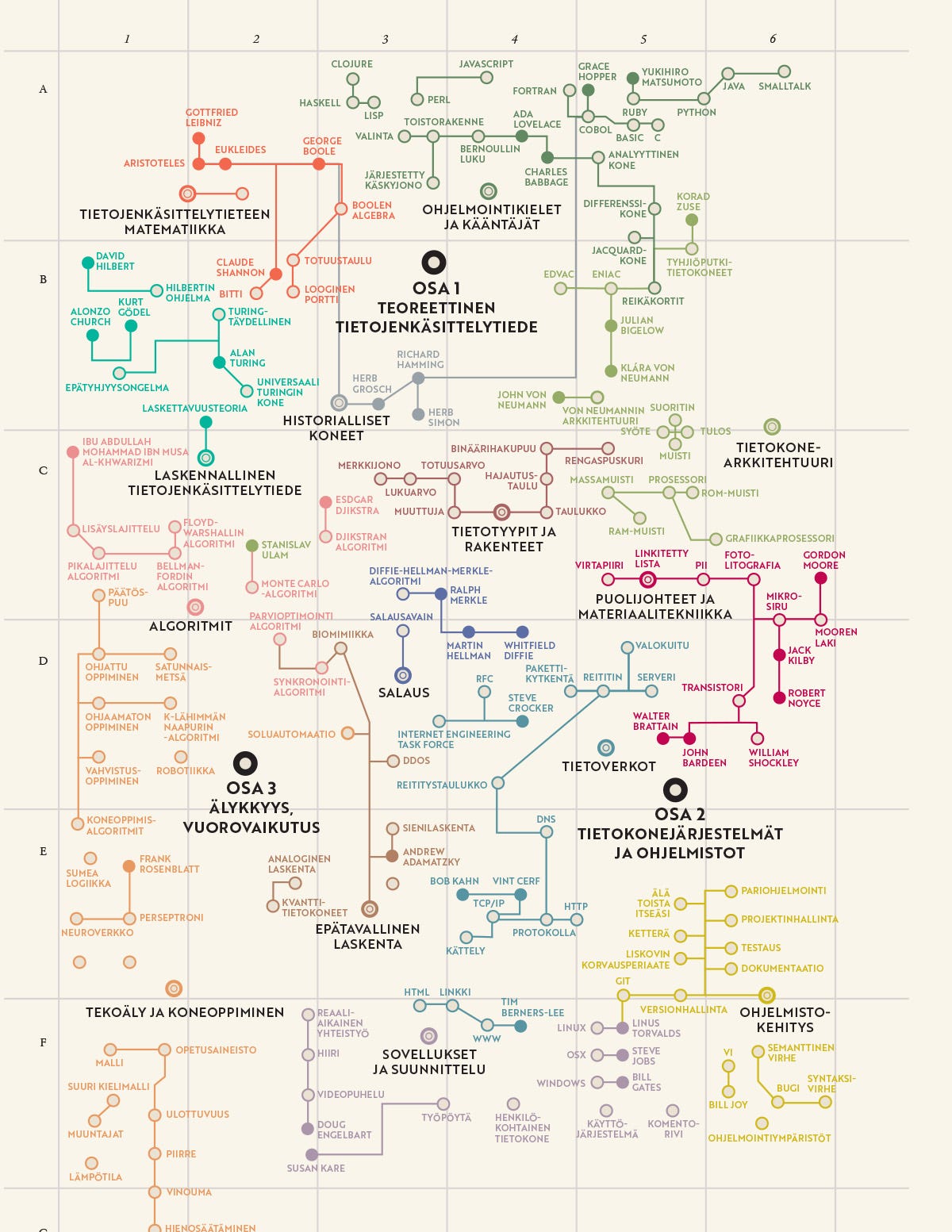
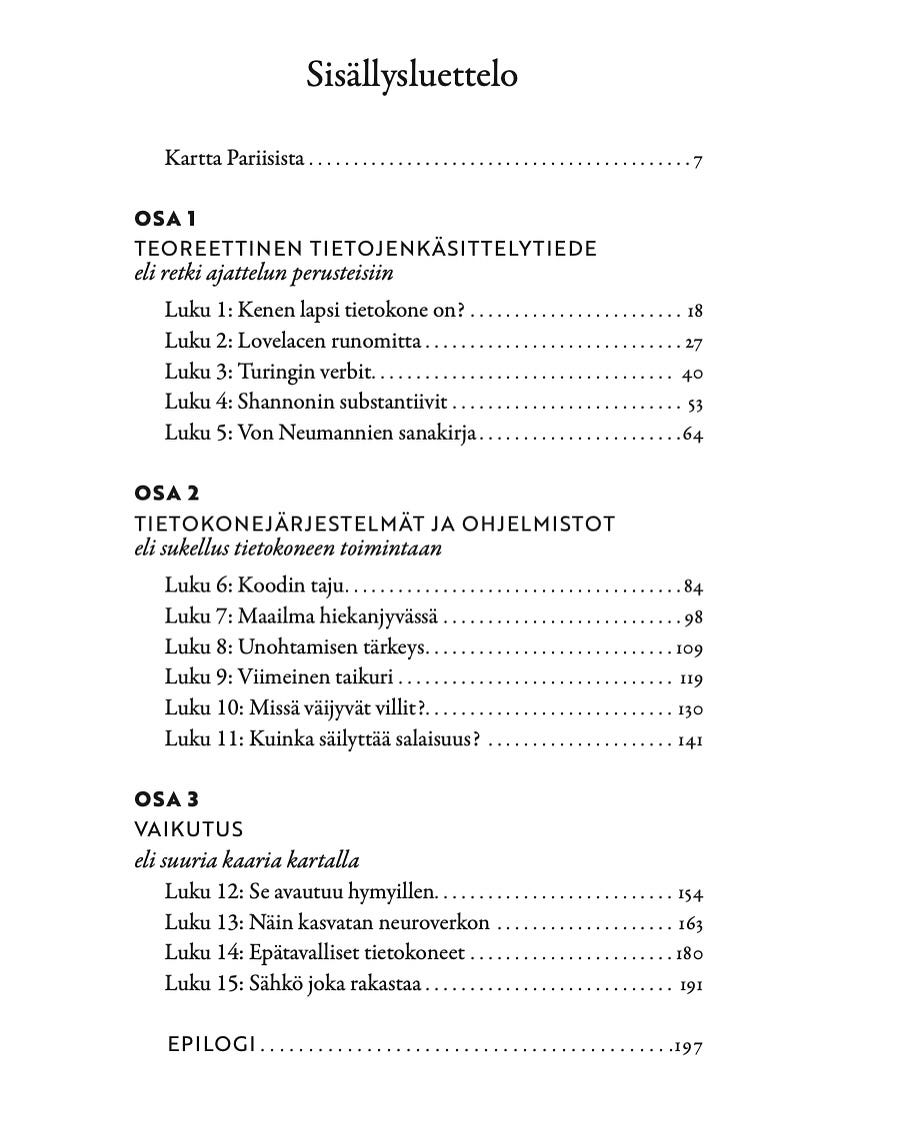
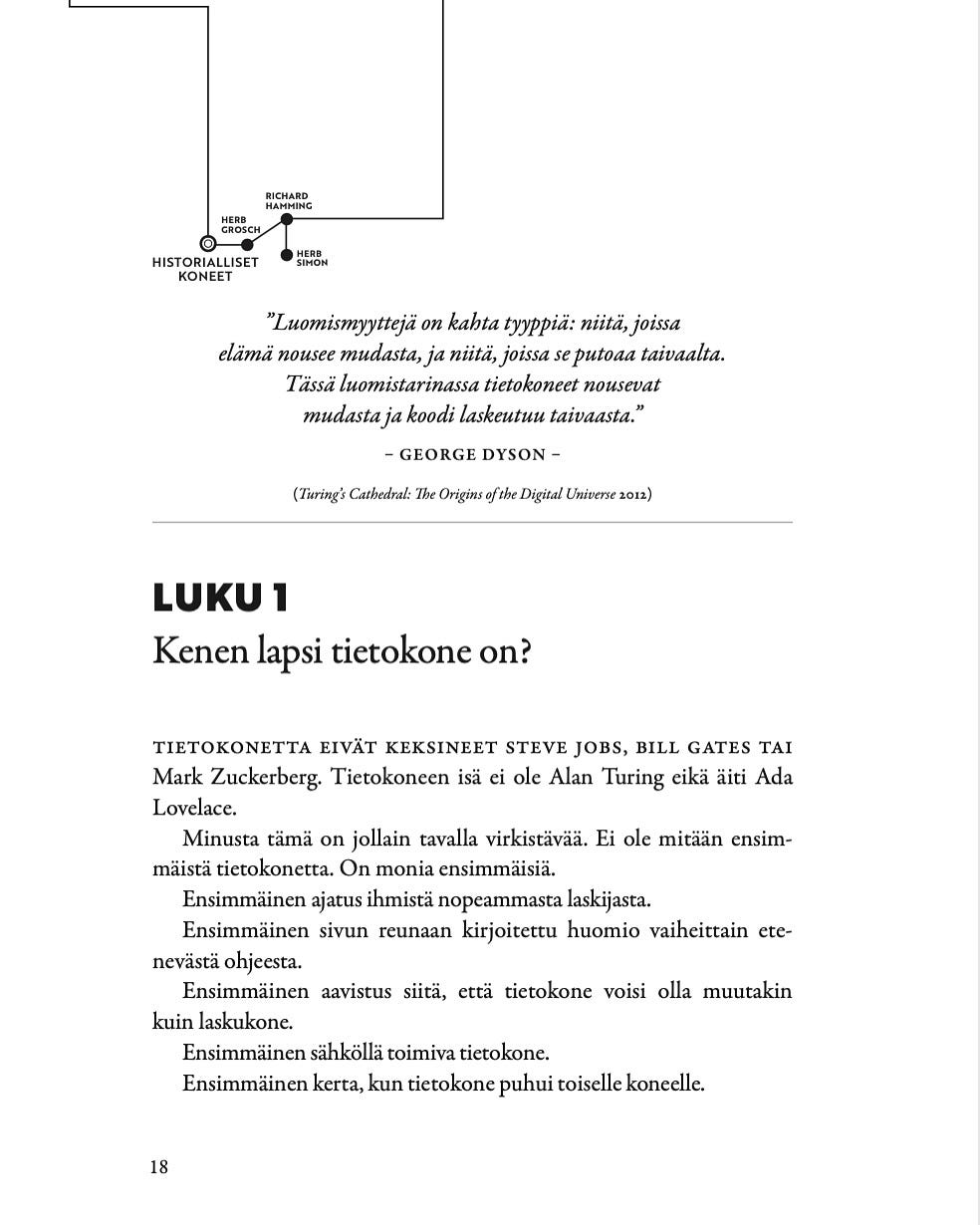
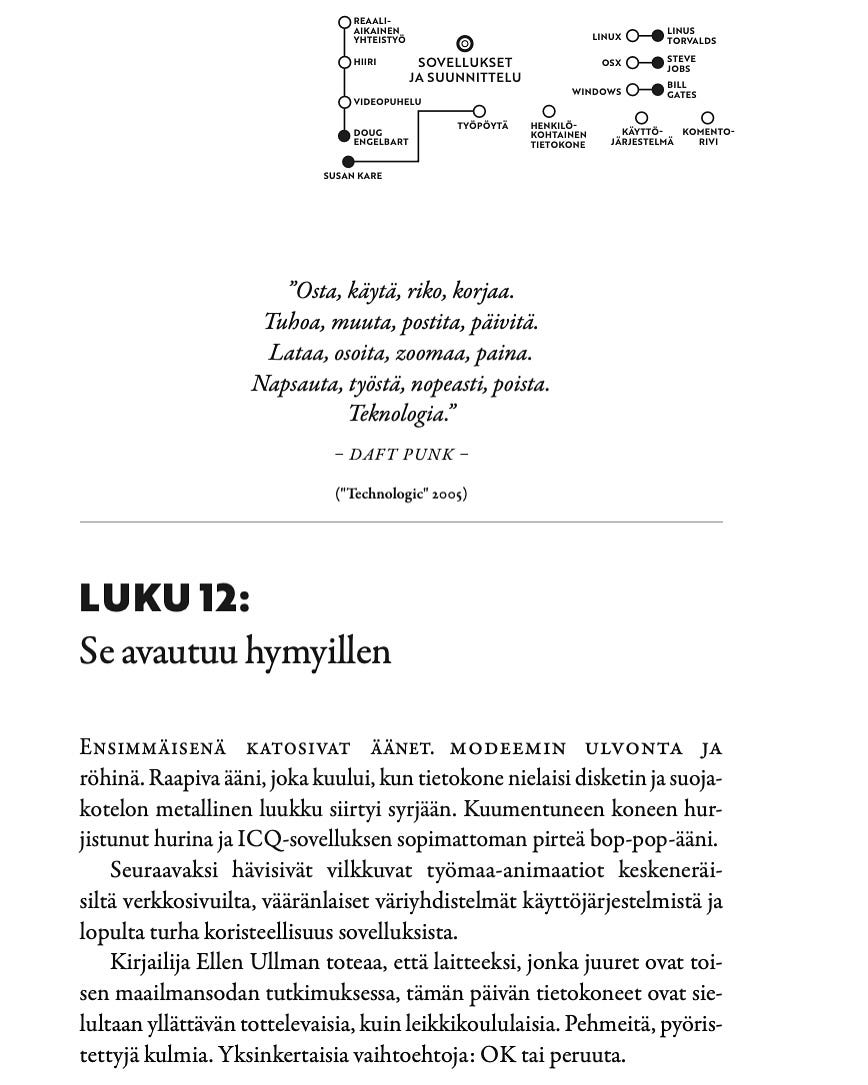
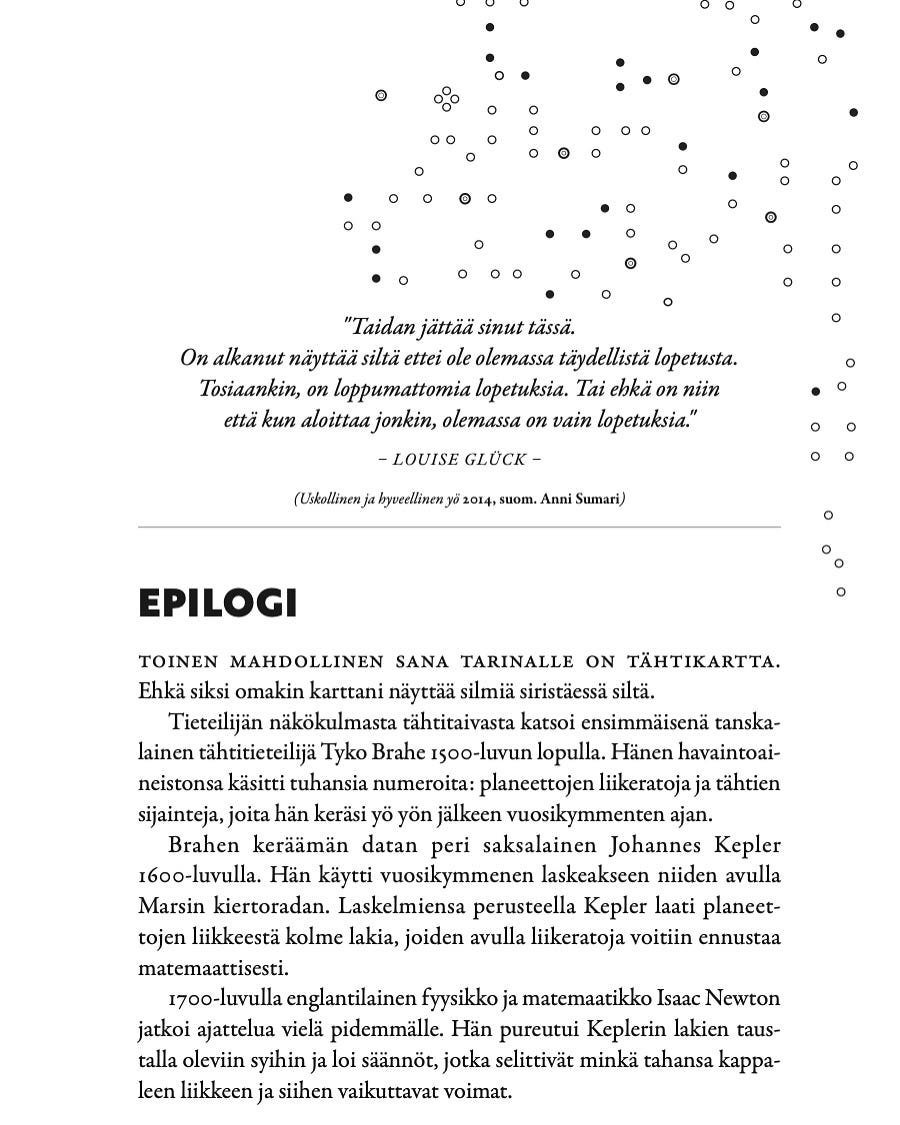
Thank you for sharing this! I absolutely love getting a peek into the connections and inspirations that fuel your work. You have an amazing way of pulling together history, life, play, and others' ideas that is inspiring.
Congratulations Linda, that's a huge achievement! I really hope it gets translated into English soon.